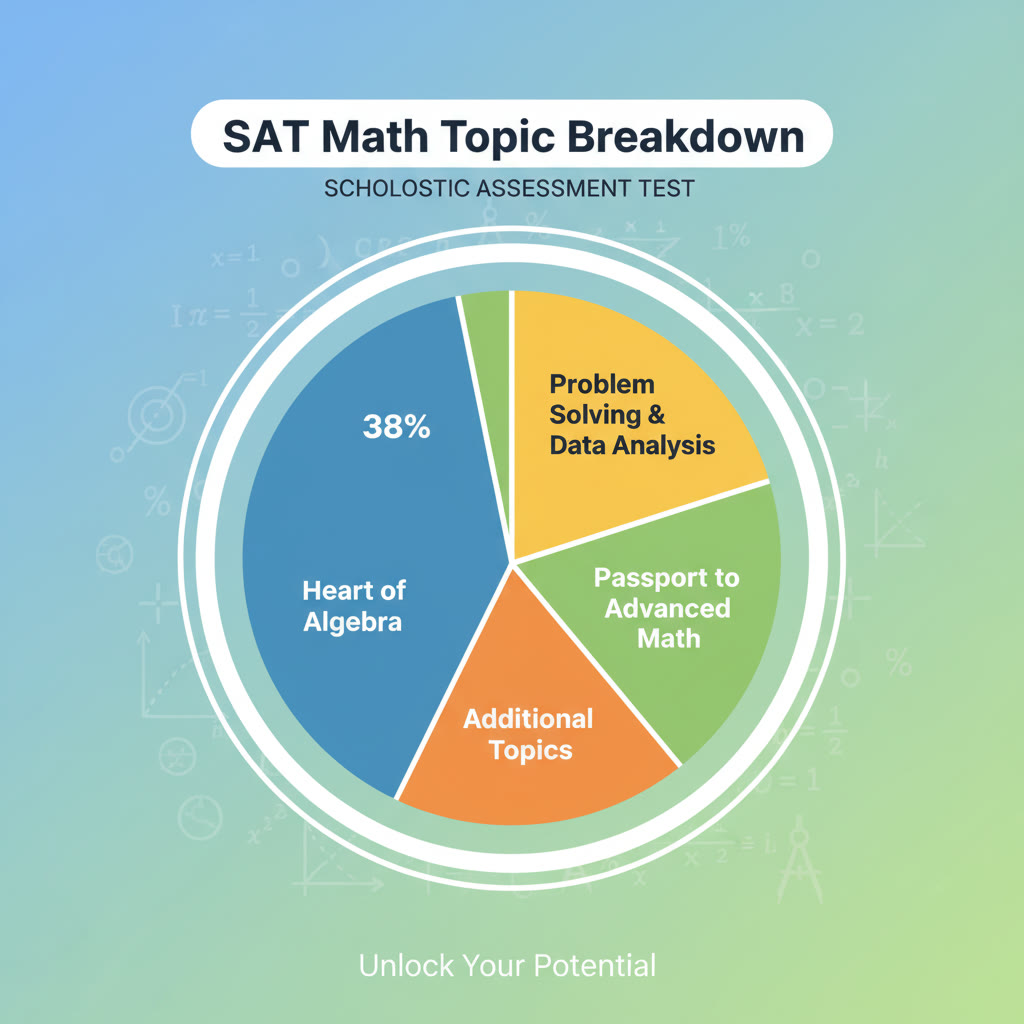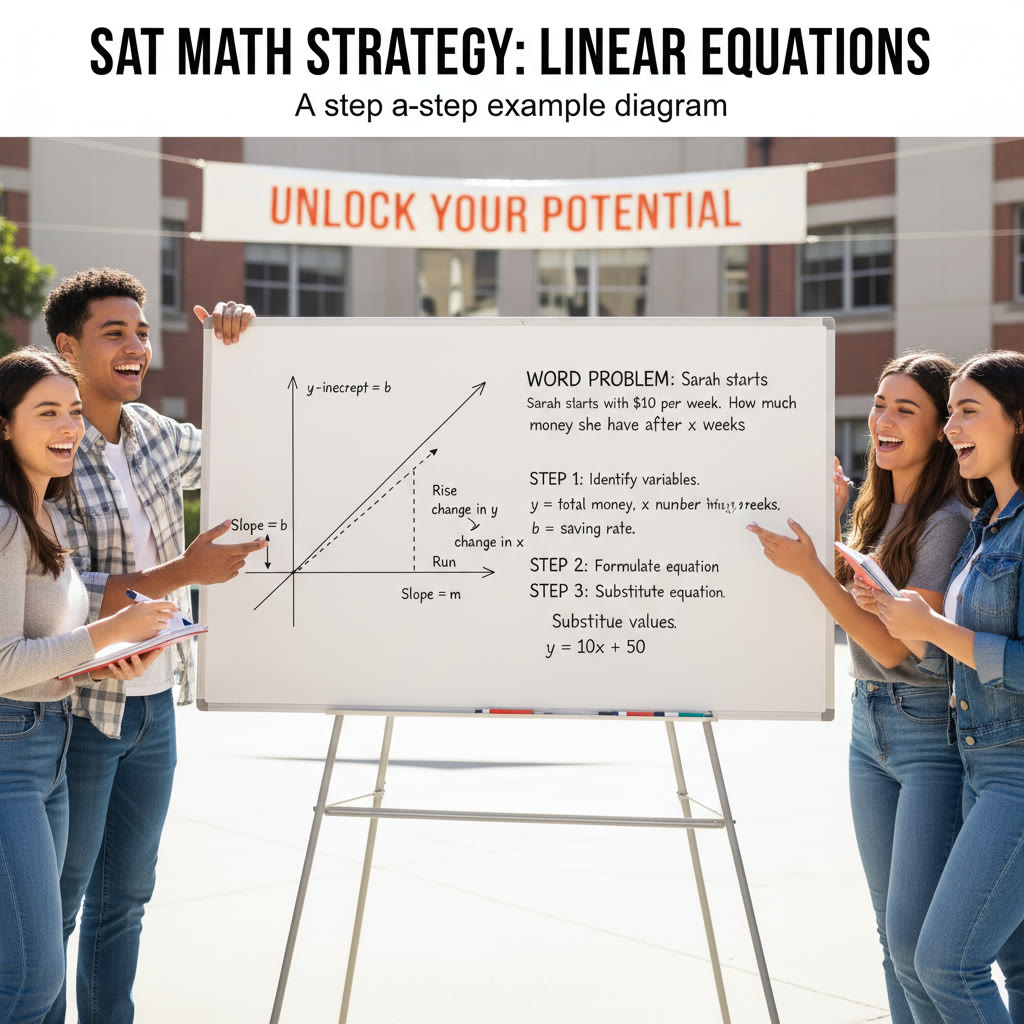Algebra Concepts That Dominate SAT Math
If you’ve ever felt the SAT Math section was a maze of x’s and y’s, you’re not alone. The good news? Algebra is the map. From linear equations to quadratics and functions, algebraic reasoning is the backbone of the SAT. Understanding how these concepts show up on the test — and practicing the ways they’re tested — will let you transform confusion into calm confidence on test day.
Why algebra matters more than you might think
The SAT isn’t trying to trip you up with obscure formulas. Instead, it rewards clear thinking, pattern recognition, and algebraic fluency. Roughly one-third of the Math section is devoted to the category College Board calls “Heart of Algebra.” Add in content from “Passport to Advanced Math” and “Additional Topics,” and algebraic skills become the single best investment of your study time.
Two math sections — a no-calculator section and a calculator-allowed section — mean algebraic manipulation, mental math, and smart setup are all valuable. Below we’ll unpack the specific topics that recur, give crisp strategies, walk through sample problems, and offer a practical study plan you can implement this week.
Quick snapshot: How the SAT divides math topics
| Algebra Category | What it includes | Approx. share of Math questions |
|---|---|---|
| Heart of Algebra | Linear equations, inequalities, systems, slope, intercepts | ~33% |
| Problem Solving & Data Analysis | Ratios, proportions, percentages, interpreting linear models | ~29% |
| Passport to Advanced Math | Quadratics, polynomials, nonlinear expressions | ~28% |
| Additional Topics | Geometry, basic trigonometry, complex numbers (occasionally) | ~10% |
Top algebra topics to master (and why)
1. Linear equations and inequalities
Linear equations are the workhorse of SAT Math. Expect single-variable equations, multi-step rearrangements, and inequalities that test your rules for reversing inequality direction when multiplying or dividing by negatives. Linear modeling — translating word problems into y = mx + b — is equally important.
- Practice isolating variables quickly and without small arithmetic mistakes.
- Be fluent with slope (rise over run), intercepts, and interpreting the meaning of slope in word problems (e.g., rate of change).
- Know how to graph an inequality on a number line and how to reason about solution sets.
2. Systems of equations
Systems show up commonly as two linear equations with two variables. You should be comfortable solving them by substitution or elimination, and also by interpreting intersection points on graphs.
- When numbers are messy, substitution might be cleaner; when coefficients align, elimination is faster.
- Look for strategic shortcuts: adding equations to cancel a variable, or rearranging to see proportional relationships.
3. Quadratic equations and expressions
Quadratics are a major part of the Passport to Advanced Math domain. On the SAT you’ll factor quadratics, complete the square sometimes, use the quadratic formula when needed, and analyze parabolas (vertex, axis of symmetry, direction).
- Factoring quickly is essential. If an expression factors cleanly, factoring is almost always the fastest route.
- Make connections between the algebraic form and the graph: the roots are x-intercepts, the constant term relates to y-intercept, and the leading coefficient controls the parabola’s stretch and direction.
4. Functions and interpreting function notation
Function notation f(x) appears often. You’ll evaluate functions, manipulate function rules, and match functions to graphs or verbal descriptions. Understand the difference between a function’s formula, its graph, and the real-world meaning of input and output.
- Be able to substitute expressions for x and to interpret composite expressions like f(2x) vs 2f(x).
- Translate words to functions: “distance as a function of time at constant speed” becomes d(t) = vt + d0.
5. Exponents, radicals, and rational exponents
Rules of exponents — product rule, quotient rule, power-of-a-power, negative exponents — appear frequently. You’ll also see square roots and nth roots written with fractional exponents. Simplifying these expressions and rationalizing denominators are part of the toolkit.
- Practice converting radicals to rational exponents and vice versa.
- Watch signs: even roots require nonnegative radicands when the context is real numbers.
6. Absolute value
Absolute value questions test your understanding of distance on the number line. Instead of memorizing formulas, think logically: |x − a| < b means x lies in the interval (a − b, a + b), while |x − a| ≥ b splits into two rays.
- Translate absolute value inequalities into compound inequalities for quick solution.
- Graph reasoning often gives intuition faster than algebraic manipulation.
How algebra problems are typically presented on the SAT
Multiple formats to watch for
- Multiple choice with four answer options (including one or two grid-in style numeric entry parts).
- Graph interpretation questions where you read slopes and intercepts from a plotted line or curve.
- Word problems that require translating sentences into algebraic expressions or equations.
Remember: some questions are straightforward algebra, and others are algebra wrapped in context. Translating story problems into equations is a high-return skill because many students lose points just from messy setup.
Common algebra traps and how to avoid them
- Arithmetic slip-ups: keep work neat, and when possible, pick numbers to simplify before heavy algebra.
- Incorrect sign handling: double-check negative signs when distributing and solving inequalities.
- Misreading what a question asks: circle or underline key words like “value of x,” “maximum,” “at least,” and units.
Examples: Walkthroughs that clarify the approach
Example 1 — Linear equation from a word problem
Problem: A photographer charges a flat fee of $50 plus $10 per person for a portrait session. If a group pays $170, how many people were in the group?
Set it up: total = 50 + 10n, where n is number of people. Solve: 50 + 10n = 170 → 10n = 120 → n = 12. Clear setup, no surprises.
Example 2 — System of equations
Problem: Two students together have 44 pencils. One student has 4 more pencils than twice the number the other has. How many pencils does each student have?
Let x = pencils of student A, y = pencils of student B. We have x + y = 44 and x = 2y + 4. Substitute: (2y + 4) + y = 44 → 3y + 4 = 44 → 3y = 40 → y = 40/3. Pause: that’s not an integer, and since pencils are whole, check setup.
Correction: interpret carefully. If “one student has 4 more than twice the number the other has,” and the variables were swapped, try x + y = 44 and y = 2x + 4. Then x + (2x + 4) = 44 → 3x + 4 = 44 → 3x = 40 → x = 40/3 — still not integer. That suggests the problem as stated should produce integers; in SAT-style questions fractional answers are possible but uncommon in basic counting contexts. This example shows why checking the reasonableness of solutions matters. If this were an actual SAT question, the phrasing would avoid ambiguity.
Key lesson: set variables clearly, re-read the sentence, and interpret relationships precisely. On the SAT, a quick check for integer or realistic answers can catch a setup mistake.
Example 3 — Quadratic factoring and roots
Problem: If f(x) = x^2 − 5x + 6, what are the zeros of f?
Factor: x^2 − 5x + 6 = (x − 2)(x − 3). So zeros are x = 2 and x = 3. On the SAT you might be asked for a sum, product, or to match this function to a graph; knowing factoring connects algebra to geometry immediately.
Practice strategies and tricks that save time
1. Plug in numbers when stuck
If a question has variables in answer choices or symbolic parameters, try plugging in convenient numbers to make the algebra concrete. This is especially useful on multiple-choice problems with variable expressions in answers.
2. Work backward from answer choices
On multiple choice algebra problems, sometimes it’s fastest to substitute each answer into the original equation and see which one works. This is often quicker than solving symbolically.
3. Use unit analysis and reasonableness checks
Especially on word problems, check that your numeric answer makes sense in context. If you model cost, rate, or time, double-check units.
4. Know when to use the calculator — and when not to
The SAT has a no-calculator section where algebraic fluency and mental math are your best allies. Use the calculator strategically in the calculator-allowed section for messy arithmetic, but don’t rely on it for conceptual work like factoring or interpreting graphs.
Study plan: 6-week algebra-focused roadmap
This plan assumes a few hours per week. If you’re short on time, compress; if you have more, spread topics out.
| Week | Focus | Daily tasks (30–60 minutes) |
|---|---|---|
| 1 | Linear equations & inequalities | Practice solving, graphing, setup from word problems, timed no-calculator drills |
| 2 | Systems of equations & modeling | Substitution/elimination, interpret intersections, practice translations from context |
| 3 | Quadratics: factoring, vertex, quadratic formula | Factor sets, solve roots, match equations to graphs |
| 4 | Functions, exponents, radicals | Evaluate functions, simplify exponents, convert radicals |
| 5 | Mixed problem sets & timed sections | Full-length practice sections, review mistakes deeply |
| 6 | Targeted review & test strategies | Polish weak spots, practice no-calculator speed, relaxation techniques |
How to use practice tests most effectively
- Simulate test conditions sometimes (timed, no phone, quiet room).
- Always review every mistake. Ask: Was it conceptual, careless, or misread?
- Create a “mistake bank” and revisit errors until they stop recurring.
Common pitfalls and how to get unstuck
Algebra panic mode
When a problem looks messy, slow down. Often a messy expression simplifies or a substitution (let u = complicated expression) turns an intimidating problem into a routine one. The SAT rewards calm, strategic choices over speed that turns into errors.
Overcomplicating problems
Look for factoring, common denominators, or algebraic identities that simplify your work. For example, if you see x^2 − y^2, remember the difference of squares: (x − y)(x + y). These identities are time-savers.
Missing domain constraints
Watch for implied restrictions: denominators can’t be zero, even roots require nonnegative radicands in real numbers, and function domains matter when substituting values. These constraints often determine the correct choice or eliminate extraneous solutions.
When personalized help speeds your curve
Algebra is a skills game: targeted practice plus smart feedback accelerates progress. That’s where personalized tutoring shines. Sparkl’s personalized tutoring model — with 1-on-1 guidance, tailored study plans, expert tutors, and AI-driven insights — helps you identify which algebra topics are leaking points and builds a plan to plug them. The human tutor interprets the AI’s recommendations and translates them into practice that matches your learning style.
One-to-one sessions are especially useful for:
- Clarifying persistent misconceptions (for example, common errors when solving inequalities).
- Working through timed strategies so you can maintain speed without losing accuracy.
- Designing a study plan that focuses on your highest-impact weaknesses.
Final checklist before test day
- Be fluent with solving linear equations and systems — they’re everywhere.
- Practice factoring quadratics until it feels automatic.
- Know exponent rules inside and out, including fractional and negative exponents.
- Be comfortable translating word problems into equations; practice with real-world setups (rates, mixtures, percent change).
- Do at least one full timed practice math section under test conditions within the last week before the test.
Image suggestions


Parting thoughts — algebra as a tool, not a hurdle
Algebra on the SAT is less about memorizing obscure tricks and more about pattern recognition, translation of words into equations, and calm manipulation of expressions. Practice those habits deliberately: set up problems cleanly, check for reasonableness, and build speed with accuracy.
If you want help turning practice into progress, consider mixing self-study with targeted tutoring. Sparkl’s personalized tutoring pairs expert tutors with AI-driven insights to create tailored study plans and 1-on-1 guidance that helps you focus on the algebra topics that really move the needle on your score.
Above all, don’t let a few tricky problems define your preparation. Algebra is a learned skill: with the right structure, steady practice, and occasional guided feedback, you’ll find the patterns that make SAT Math feel straightforward — even enjoyable. Good luck, and keep solving!




















No Comments
Leave a comment Cancel